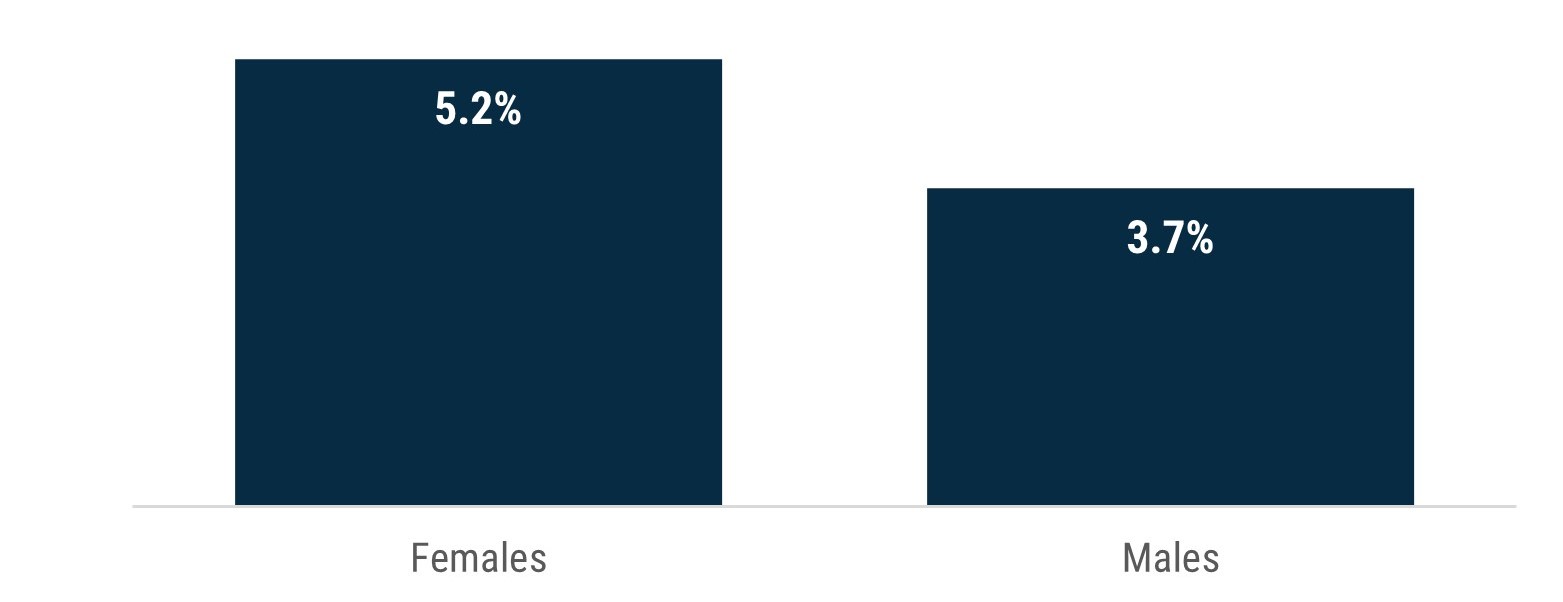On this page
At the 2021 Census 7,516 Boroondara residents sometimes needed help with movement, communication or self-care due to a long-term health condition, disability or old age. This is considered by the Australian Bureau of Statistics as indicative of severe or profound disability and includes 4.5% of Boroondara residents, lower than the Greater Melbourne rate of 5.5%.
Applying a broader definition of disability, in 2018 around 11.4% of Boroondara residents, or 20,500 people, had limitations or impairments which restricted their everyday activities for at least 6 months. (See note at the bottom of this page for sources.)
More females have disability than males (Figure 1). As well as possibly being related to higher prevalence of disabling conditions like osteoporosis among older females, this is also because disability rates increase with age (Figure 2), and there are more females than males in older age groups.

Figure 1: The 2021 Census showed that female Boroondara residents are more likely to need help due to disability than male residents. Data source: Informed Decisions Boroondara Need for assistance statistics

Figure 2: Older Boroondara residents are more likely to need help due to disability than younger Boroondara residents. Over half of residents aged 85 and over need help due to disability. Data source: ABS Tablebuilder Pro, 2021 Census
At the 2021 Census, 20% of those with disability (1,492 Boroondara residents) lived alone in a private dwelling. An additional 23% (1,741 Boroondara residents) lived in a non-private dwelling, mainly nursing homes or other accommodation for older adults.
The number of Boroondara residents needing help in their day-to-day lives due to disability went from 6,406 people (3.8%) in 2016 to 7,516 people (4.5%) in 2021. This upward trend is likely to continue as the Boroondara population ages.
Carers of people with disability
The Census asks everyone who is 15 years and over to report whether they spent time providing unpaid care, help or assistance to family members or others because of disability, a long-term illness or problems related to old age in the 2 weeks prior to the Census.
At the 2021 Census, 14.3% of Boroondara residents aged 15 and over and 12.6% of Greater Melbourne residents were carers based on this definition. Most carers are female (Figure 3) and caring rates peak for residents in their 50s and 60s (Figure 4).

Figure 3: 60% of carers in Boroondara are female. Data Source: Informed Decisions Boroondara Unpaid care statistics

Figure 4: Caring rates peak in Boroondara between 50 and 69 years. Almost a quarter of residents in this age bracket are carers. Data source: ABS Tablebuilder Pro, 2021 Census
Note: This estimate applying a broader definition of disability is based on people in Boroondara with disability who live in households from Australian Bureau of Statistics 2018, ‘2018 SDAC LGA modelled estimates’ [data set], Disability, Ageing and Carers, Australia: Summary of Findings, accessed 7 September 2022, combined with count of Boroondara residents with need for assistance living in a hostel for the disabled, nursing home or aged care facility, from Australian Bureau of Statistics 2016 and 2021, Core Activity Need for Assistance (ASSNP) by LGA and Type of Non-Private Dwelling (NPDD) [Census TableBuilder Pro], accessed 7 December 2022.